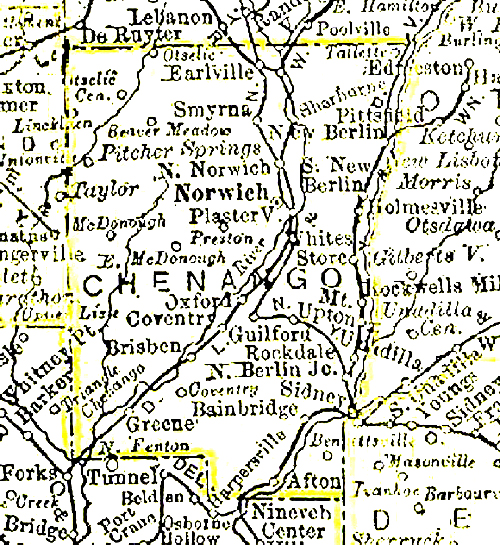First settlers of Smyrna, Chenango, New York
By Kathryn Hall | January 14, 2009
Early settlers of the town of Smyrna, Chenango County, New York found in James H Smith’s History of Chenango and Madison Counties (1880) are listed below. Smyrna was formed from Sherburne first as Stafford, March 25, 1808, and its name was changed to Smyrna on April 6, 1808.
It is noteworthy that one of the first settlers listed is Joseph Tobey who arrives in Smyrna in 1792. Mehitable “Hitty” Orinda Tobey later marries Erastust Gilbert Hall, son of Luke Hall, of Somers.
1792, August
first settler-Joseph PORTER, Conway, Mass
second-Joseph TOBEY, native of Conway, Mass1793
David WILBUR (now WILBER), Nine Partners, Dutchess Co.,
Joseph COLLINS, Somers, Tolland, Co., Conn, and
Joseph BILLINGS, Somers, Tolland Co., Conn1795
Hopson WILLCOX & son, Lillibridge, Exeter, R.I.
Hon. Isaac FOOTE, born Colchester, Conn; Stafford, Conn 1773; then Smyrna1795 or ‘6
Elijah SEXTON, born Somers, Conn1798
Simeon REXFORD
John BILLINGS, native of Stonington, Conn previous to 1800
John PARSONS1799
John PERCIVAL1800
Obadiah SPENCER,
Stephen PARKER1803
Jesse HUTCHINSON
Apollos ALLEN
Squire John MUNSON
Alpheus HALL
Col. Solomon HALL
Aaron HUTCHINSON
William STOVER
David FELT
Comfort RECORD
John PARKER
Luke HALL – Somers, Conn
According to History of Chenango & Madison Counties, “Luke Hall came at an early day from Somers, Conn. and settled in the north part of town, where his son Erastus now lives, and died there, he and his wife.” Luke Hall’s wife was Ruby (Pease) Hall, of Somers.
Most remarkably, a fellow researcher, and distant cousin, a descendant of Alpheus Hall, generously made the trek last year to Smyrna to photograph the old homestead of Erastus Gilbert Hall, which is still standing!

Old homestead of Erastus Gilbert Hall

Old homestead of Erastus Gilbert Hall
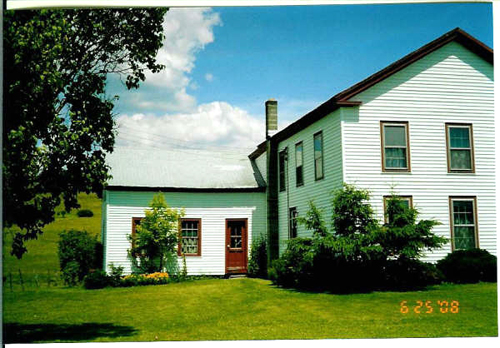
Old homestead of Erastus Gilbert Hall
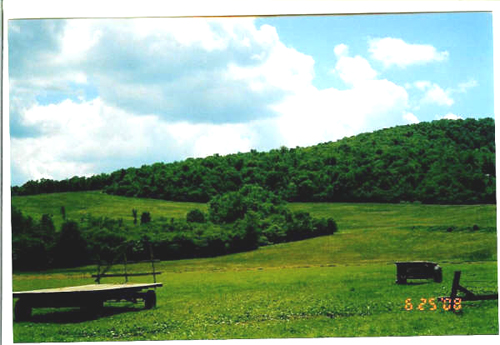
Land at old homestead of Erastus Gilbert Hall
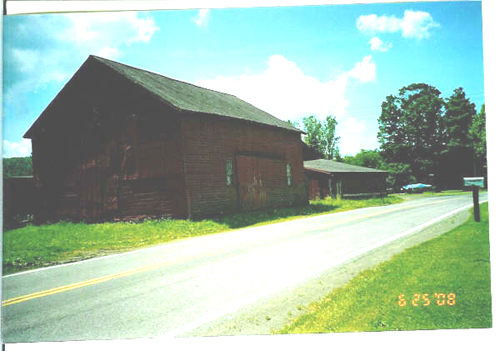
Barn at old homestead of Erastus Gilbert Hall
Topics: New York | No Comments »
Mystery or Blind Spot? Who is in this grave?
By Kathryn Hall | January 12, 2009
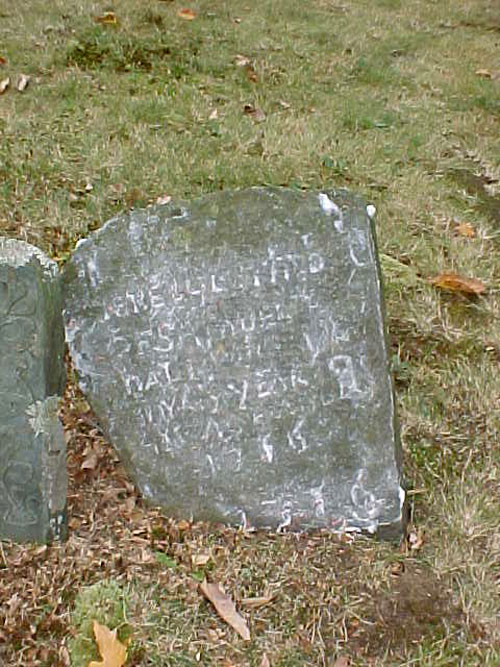
Photos courtesy of Brady E. Fitts
The above simple, very old gravestone has in the past been the subject of much debate between various researchers of the families descended from Edward Hall of Rehoboth and from George Hall of Taunton. Why this has been debated is a mystery when the facts are set forth, but since so much time has been spent in this circular dialogue and many words (and implications) now stand that the review of this debate deserves, indeed, requires a deeper intelligent look. This particular headstone stands in the Pleasant Street Cemetery in Raynham, Bristol County, Massachusetts.
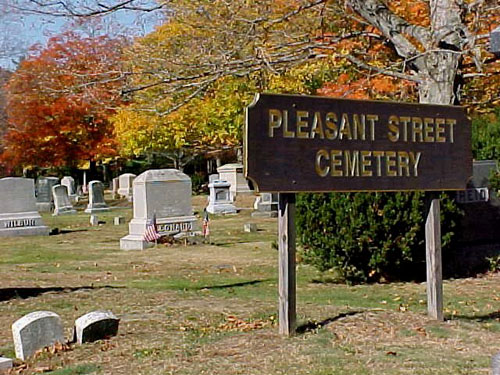
While the stone is very old and weathered what is not disputed is that the stone bears the name Samuel Hall and the date of his death, 1716. What is in dispute is whether the stone reads “died in his 53d yr.” or “died in his 59th yr.” It would appear that reseachers who held sway that this particular Samuel Hall was a descendant of George Hall want that number to be a “3.” Those who are clear this Samuel Hall was a descendant of Edward Hall subscribe to the number being a “9”. The Number Three people obviously did not take into account Marsha Hoffman Rising’s deed sleuthing. Nevertheless. Here are the facts regarding our Samuel Hall in question.
The Facts.
Samuel Hall, Jun., maried to Abigaill Prat of Plimouth, 3 Jan. 1683. Jonathan, son of Samuel, borne 22 Aug. 1686. (Both entries from the Proprietor’s Records by E.H. Reed, Esq. of Taunton.) Note! It is wise to recall that in 1683 there are three Samuel Halls in Taunton, thus the ensuing debate, being:
Samuel b. 1644 (son of George)
Samuel b. 1656 (son of Edward)
Samuel b. 1664 (son of Samuel, grandson of George)
And big reminder:
Samuel b. 1644 was called Sr. due to his being the elder in town
Samuel b. 1656 was called Jr. as he was next in age
Samuel b. 1664 was called “son of Samuel”
The titles Jr. and Sr. in the 1600’s were not family-specific as it is today; it was town-specific. Without this piece of knowledge the research of these three Samuels becomes immediately murky and confusing.
7 Feb. 1686 Samuel Hall, son of Edward Hall of Rehoboth deceased, and his wife Abigail entered into a contract to sell 8 acres of land (Documentation is the copy of the deed, which was mysteriously filed ten years after the purchase.)
Will of SAMUEL HALL of Taunton, dated 21 August 1716, recorded 26 November 1716. Wife Abigail. Sons Jonathan (eldest) & Samuel (youngest). Daughters: Esther Blake & Hannah Hall (youngest). “The lad who lives with me, namely Ebenezer Pratt (under 21). “The girl who lives with me Elizabeth Pratt” (under 17). Witnesses” Abraham Jones, Samuel White & Jabez Prat (3:307/8/9) (Bristol County, MA Probate Records, Book 1)
Inventory of Estate of Samuel Hall of Taunton, who died 30 August 1716, dated 27 September 1716, presented by Jonathan Hall, eldest son & Abigail Hall, his widow. Apprs.: Henry Hodges, Samuel Leonard & Stephen Leonard (3:309/10)
Lastly:
Jonathan Sr. Hall, son of Samuel Sr. Hall and Abigail Pratt, was born on 22 Aug 1686 in Taunton, Bristol, MA, died on 19 Apr 1750 in Raynham, Bristol, MA at age 63, and was buried in Town Cemetery at Raynham Center (Massachusetts Vital Records to 1850, Taunton Births.
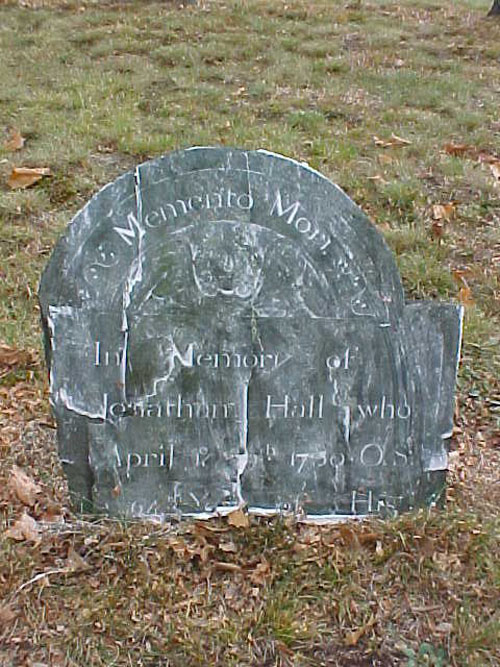
Ironically it would appear from all of the above that this documentation would appear not in the family records of the descendants of George Hall, but in the family records of the descendants of Edward Hall of Rehoboth. And I am certain they will. Unfortunately, there are researchers of the descendants of George Hall who in the past have labored over that single digit, throwing a shadow over the subjective interpretation of the 53 (or 59), thus finding further “evidence” to tangle these two families.
Note, it is my sole intention to seek only the truth of this matter. If you have further information that might shed more light on this decades old controversy, your comments will be welcomed.
Thank you.
Topics: Massachusetts | 4 Comments »
Samuel & Abigail Hall 1686 Deed, Taunton, Bristol, MA
By Kathryn Hall | September 6, 2008
As stated early on one of the challenges of sorting out the ancestors of George Hall has been to clarify the confusion created by earlier genealogists in their documentation of the descendants of Edward Hall and the descendants of George Hall who were both named Samuel. We have been indebted to the research of Marsha Hoffman Rising, who turned to land deeds, deepening her research and shedding light on this problem. Her conclusion was, “In short, the Samuel who married Abigail Pratt in 1683 was clearly the son of Edward of Rehobeth. After selling their land in 1686, the couple moved from Taunton.” Following is the deed for Samuel and Abigail Hall in full text.
Bristol Co. Northern District Registry of Deeds, Taunton, Massachusetts, Book 2, Page 35
To all Christian People before whom these presents shall come Samuel Hall Sen(e) of Taunton in the county of Bristoll in the Coloney of Newplimuth the son of Edward Hall of Rehoboth Decease and Abigaile his wife Send Greeting &c Know yee that the said Samuel Hall and Abigaile his wife; for & in Consideration of Eight acrees of land sold to the said Samuel Hall by Thomas Leonard of Taunton above said a Deed whereof they do hereby acknowledge that they have Received under the hands and seals of the said Thomas Leonard and Mary his wife, and thereof Do by these presents fully acquit and Discharge the said Thomas Leonard his heires executors, & Administrators forever by these presents, Have Given granted sold made over Confirmed and Delivered unto the said Thomas Leonard his heires and assignes for ever Eight accers of land be it be it more or less Scittuate lyeing & being and be in the town = ship of sd Taunton at a place called old Coleing which eight accers was part of a Grant from sd town to James Tesdale and was sold allso by said Tesdale with other lands to the said Hall and it was Measured and layed out to the said Leonard with and among other lands at the said old Coleing on the Southerly side of the way that leadeth between the land of said Leonard and said Hall To have and to hold the said eight accers as it is above expressed to him the said the said Thomas Leonard his heirs and -Assigns for ever with all the Benefitts and profitts thence ariseing-Together with all the appurtenances within and upon the same or any way thereonto belonging and moreover the said Samuel and Abigaile doe by these presents Covenant and Promise to & with the said Thomas Leonard that they have good Rightfull power & lawfull authority in their-owne Names to give grant Sell Deliver Convey & Confirme the said eight accres with all its Rights & priviledges as above said and that it shall be lawfull for the said Thomas Leonard his heirs and Assigns to have hold occupie & enjoy the same peacably & Quietly without any trouble or Molestation that may arrise from by or under them the said Samuel Hall or Abigaile his wife their heires or any- other person that may lay any lawfull Claime thereonto or any part thereof for ever, and hereonto the said Samuel Hall and Abigaile have set their hands and seales this seventh Day of february in the year of our Lord god one Thousand six hundred Eightty Six the word (wife) in the third line was before the Ensealing hereof.
The mark of
Samuel Hall (seale)
The mark of
Abigail Hall (seale)Signed sealed & Delivered
In the presence of us
James Leonard Sen (e)
his mark
Joseph Leonard
his mark
John CraneThe said James Leonard, Sen (e) and Joseph Leonard and John Crane took oath that they saw the said Samuel Hall and Abigail Hall signe seale & Deliver this Instrument as their Act and Deed. And the said Samuel Hall and Abigaile Hall were present at the-same time and Did acknowledge this instrument to be their Act and Deed on the seventh Day of february, 1686. In Taunton before Thomas Leonard Assosuate
Thus entered and Recorded the 10th of february 1696 by John Cary Recorder
Topics: Massachusetts | 2 Comments »
Pease family in West Cemetery, Somers, CT
By Kathryn Hall | August 24, 2008
As we explore some of the Hall/Pease connections in Enfield and Somers, CT I return to the gravestones that mark some of that early history in West Cemetery, Somers, CT. Given that tomorrow marks the Democratic National Convention in Denver where Barack Obama will formally accept the Democratic Party’s nomination for President, I thought it fitting to note the following in our extended maternal history.
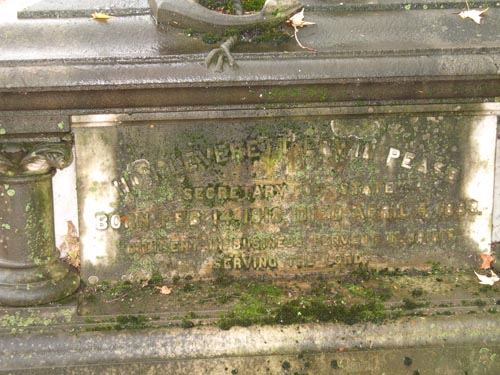
Hon. Leverett Erwin Pease, Secretary of State, Born Feb. 14, 1818, Died April 4, 1883
Diligent in business, fervent in spirit serving the Lord
from Political Graveyards:
West Cemetery
Somers, Tolland County, Connecticut
Politicians buried here:
• Leverett Erwin Pease (1818-1883) — also known as Leverett E. Pease — of Somers, Tolland County, Conn. Born February 14, 1818. Republican. Delegate to Republican National Convention from Connecticut, 1860; Secretary of State of Connecticut, 1866-69. Died April 4, 1883. Interment at West Cemetery.
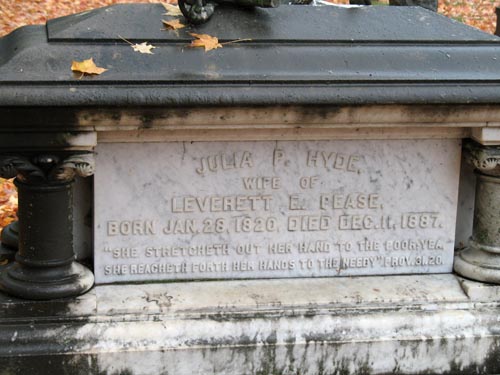
Julia P. Hyde wife of Leverett E. Pease, Born Jan. 28, 1820, Died Dec. 11, 1887.
“She stretcheth out her hand to the poor, yea, she reacheth forth her hands to the needy.”
Prov. 31.20
Topics: Connecticut | No Comments »
Historical Sketch of the Town of Enfield
By Kathryn Hall | August 24, 2008
Those familiar with the Hall history will recognize the family names of Parsons and Pease in the manuscript which follows. Many Halls married into the Parsons and Pease families. Indeed, they are in integral part of our early American history.
AN HISTORICAL SKETCH OF THE TOWN OF ENFIELD,
BY JOHN CHAUNCEY PEASE, M. D., 1829.
The first settlers on the banks of the Connecticut generally located themselves in the vicinity of some of the beautiful & fertile meadows that are interspersed along the borders of that delightful river. The cause for such selections needs no explanation as those charming alluvial tracts were undoubtedly disforested when first discovered & had long been the seats of aboriginal cultivation. The inviting appearance of those meadows, the superior facilities which they afforded for immediate subsistance soon peopled these borders while the heavily timbered regions adjacent though of a strong & rich soil were long neglected. Of this last description was the character of the romantic & highly interesting country which lay against the falls on the Connecticut. This tract of country did not therefore become the abode of civilization until near fifty years after the settlements in its neighborhood above & below the falls although it was granted to the town of Springfield as early as 1648 by the General Court of Massachusetts.
The first effectual attempt to settle the land at the falls by the town [of] Springfield was made in 1679, although a few grants bad been made as early as 1674 & a saw mill had been erected at Freshwater by Major Pynchon which was probably burnt by the Indians in 1675.
At a town meeting held August 14, 1679 a Committee of five persons were appointed by the Town of Springfield viz John Pynchon Samuel Marshfield Thomas Stebbins Sen. Jonathan Burt and Benjamin Parsons, to manage the concerns of the proposed plantation at the Falls & at Freshwater.
Richard Fairman was Representative [?] The Committee accordingly held their first meeting Oct. 31st of from Newtown, 1768. the same year, and resolved to make grants of land at the Freshwater Plantation as it was then called, to such of the inhabitants of Springfield as would become actual settlers & to such other persons as should be approved by the Committee.
The conditions of the settlement as adopted by the Committee Dec. 3, 1679 were that the settlers should have grants of land on condition that they should settle their lots within three years from the date of their grants. In case of failure to comply with these terms these lots were to be forfeited & become again the property of the original proprietors. The settlers were furthermore restricted from selling their allotments until after an occupation of seven years.
The Committee further resolved that there should be four sorts of allotments as follows, a home lot & 30, 40, 50 & 60 acres of field land & a proportional share of meadow.
At the same meeting it was also resolved that the first settlers should have their choice after the Committee & ministry lots that the lands above & below the town plot should be laid into common fields.
Grants of home lots & out lots were then made to the nineteen following individuals. Samuel Stebbins, Thomas Gilbert, Thomas Jones, John Merrick, Charles Ferry, Nathaniel Mun, Jonatban Bush, Thomas Day, Samuel Terry Sen, Isaac Morgan, John Pierse, Rev. Pelatiah Glover, Lieut. Thomas Stebbins, Major John Pynchon, Benjamin Parsons, Jonathan Burt, Nathaniel Burt, John Bliss, & Samuel Bliss, all of the above mentioned Persons were Inhabitants of Springfield three of them only afterwards became actual settlers in Enfield viz Jonathan Bush Isaac Morgan & John Pierse.
Major John Pyrchons share was a double home lot of 24 acres & 180 acres of out land.
At [a] subsequent Proprietors Meetings held in the following months of March & April it was agreed to extinguish the Indian title as soon as possible, a grant of land was made to Thomas Bancroft & the extraordinary Grants made to Major John Pynchon were located most advantageously for his interest 50 acres were alotted to him adjoining his sawmill south of Freshwater & it was directed that [his] 130 acres should [lie] next north of the Town Plot & be 50 rods wide on the main street extending from the river to the Plains eastwardly. 30 acres also confirmed at this meeting to Lieut. Thomas Stebbins in Freshwater meadow that bad been granted him by the Town of Springfield as early as 1674 probably the first grant of land ever made in Enfield. At a Proprietors meeting held in July 1680 Grants of land were made to John Pease sen, Elisha Kibbe John Pease jun & Robert Pease who were actual settlers from Salem, The propositions made by the Springfield Committee at their meeting in August 1679 to give donations of land to settlers on such favorable conditions probably induced the two Brothers John Pease jun & Robert his Brother to visit the land that was offered for settlement for the purpose [of] examination, they accordingly came to the tract of country now called Enfield in the year 1679 built them a Hut or cellar in the side of the hill, about 40 rods east from where the old meeting house formerly stood they there lived through the winter alone no other white person in the place. The next spring they removed their families & commenced the settlement, during the succeeding three years they were joined by nearly thirty families principally from Salem & its vicinity. So that Enfield may properly be denominated a Salem Colony.
The first year of the settlement, that is, the year 1680, the Committee determined that the town plat should extend from Major Pynchons field which was about 73 rods north of the present site of the Meetinghouse, about a mile & a half south, the southern termination was about against the Deep hole at the River. It was also resolved that there should be 64 home lots from 10 to 14 rods in width, that the main street should be 12 rods broad, that the home lots should extend on each side 160 rods, either towards the River or eastwardly from the main street.
It was furthermore resolved that there should be 4 public Roads eastwardly into the woods, one from the centre of the town plat or from where the old Meetinghouse formerly stood, one from near the north end of the town the present Somers Road, one from the south end from where the South Congregational Meetinghouse now stands, & the other to the Great Spring near the centre of the town. It was resolved that there should be two roads to the river, one the old Kings Ferry road, the other to the Deep hole from the south end of the town plat. The following year the Committee ordered that the south field should be intersected by two roads running north & south & three east & west. They reserved lots for the ministry, schools and other useful purposes. Grants were made to the following Individuals, consisting of home lots and out lands, Simeon Booth, John Burroughs, Simeon Rumarel, Daniel Collins, John Kibbee, Samuel Terry jun, Thomas Bancraft, Jonathan Pease, Isaac Gleason, Lot Killam, Rowland Thomas, Thomas Hayward, William Booth, Isaac Meacham, John Bement sen, John Bement jun, Thomas Geer, John Farman, Obadiah Abbee, Henry Abell, Joseph West, Samuel Merit, & Thomas Perkins, most of whom became actual settlers before the close of year 1683.
More than thirty families were now settled in the Plantation who were organized for civil purposes this year & chose John Pease jun, the first constable. The settlers being of a religious character made early provision for building a meetinghouse & appointed a committee for that purpose. They established religious meetings [the] following year 1684, on Sunday, the exercises of which were conducted by their principal men until they could obtain a minister. A small meeting [house] erected the succeeding year 1684.
The first birth occurred this year. The name of the child was Margaret Pease the daughter of John Pease jun, & Margaret (ADAMS) his wife. She afterwards married Josiah Colton & lived to the advanced age of 92. She died in 1775. The first person who died in the Settlement was Lot Killam, he was one of the Salem Colonists a middle aged man & left one son.
The settlers had now become so numerous that a Petition was forwarded to the General Court at Boston for the Incorporation of the plantation with Town privileges by the name of Enfield. This petition was granted the consent of the Town of Springfield having previously been obtained. The Limits of the township were to extend from Longmeadow brook six miles down the river & ten [miles] eastwardly comprising the territory DOW included in the townships of Enfield & Somers.
In 1684 the Committee confirmed to Major John Pynchon a tract of land at the southern extremity of the Township including the site where his Grandfather erected a warehouse 48 years before, this tract extended 80 rods on the river & 3 miles into the interior & was bounded north on the Saltonstall or Davidson Farm so called, which is supposed to have [been] occupied before the settlement of the town plat but was afterwards abandoned & forfeited & became the property of the proprietors of the town. A highway was reserved to extend to the river north of Major Pynchons Grant for the purpose of Building vessels & as a public landing. The first selectmen were appointed by the Committee this year viz John Pease sen, Isaac Meacham & Isaac Morgan.
Daniel Gowdy the youngest son of Samuel Gowdy died 1854 aged about 82 or 3. From 1684 to 1691 Grants were made to Samuel Parsons, William Simons, Robert Pease 2, Samuel Osborn, David Bishop, John Prior, Alexander Dobe, Ephraim French, Rev. Mr. Welch, Wm Randell, Joseph Warrener, Thomas Hale, Jedediah Strong, John Trumbull, John Adams, & Edward Whittingham, a schoolmaster; most of whom became actual settlers. The Rev. Mr. Nathaniel Welch the first Clergyman died before he removed his family to the town, be was from Charlestown near Boston, be may be considered the first minister of Enfield, he died 10′ July 1689 aged 23 years. Mr. Whittingham the schoolmaster it is supposed left the Town after a short residence.1 1 [Interlined.] The highway bet. Tery [?] & Robert Peases laid out 6 rods wide to sawmill brook. The Somers line established 1723. Capt John Pease possessed land at Sawmill brook 1712, 60 acres. The highway to E. Windsor by Chapins laid out 6 rods wide.
In 1688 the first Town Meeting was held & the town was admitted to town privileges agreeable to the act of the General Court. John Pease jun. & Samuel Terry were the first select men chosen by the people. The select men bad been previously appointed by the proprietors Committee. A corn mill the first, was this year erected at Freshwater. A sawmill bad been previously erected by Isaac Meacham & Jonathan Bush. About the same time a fulling mill was erected by Capt Isaac Meacham. In 1689 A purchase was made of the Indian sachem Notatuck of all the lands from Asnuntuck or Freshwater River down the Great River to Umsquattuck at the foot of the falls then extending eastwardly full eight miles. The consideration of the purchase was 25 Pounds sterling. The Commissioners who treated with the Indians were Major John Pynchon, Lieut Thomas Stebbills, Deac. Jonathan Burt, Benjamin Parsons, John Pease, sen. Wm Denton, & Thomas Goold, none of which were Inhabitants of the Town except John Pease. The Indians reserved the right of fishing & bunting on the lands after the cession. The date of this treaty was March 1689. Nottatuck is supposed to have been a Podunk Indian & the place of his residence at or near Warehouse Point. In 1691 a grant was made to Benjamin Parsons, Samuel Terry, & Isaac Morgan, of a tract of land on Scantick for the purpose of erecting a sawmill. This grant was at or near the mouth of Sawmill Brook so called. A sawmill was shortly after erected which was the first building erected east of the town plat. The site for this sawmill was near the Distillery on the Somers road.
John Pease supposed from Yorkshire England where the family Name abounds. In 1829 Thomas Rixsons [?] Pease Esqr, bought the Duke of Devonshires [?] beautiful estate & manor of Cleasby on the Banks of the Tees for 36500£ sterling.
After the death of Mr. Welch in 1689 the religious society in Enfield which had been organized as early as 1683 were destitute of a Clergyman until 1699 & the church was organized when Mr. Nathaniel Collins of Middletown reed a grant of the reserved allotment & settled as pastor of the church. In 1766 the second meeting house was erected. Joseph Warrener settled in Enfield 1689, came from Northfield on account of the Indians.
This year the first settlement of the eastern part of the Township including the territory now called Somers, commenced by Benjamin Jones who erected a small house about half a mile east of the present village. He with family resided there several years alone in the summer season. In the Winter he used to return to the old settlement in Enfield. In 1713 four additional settlers removed to Somers viz Edward Kibbe James Pease 1715 Timothy Root 1715 & John Megregory.
About this time settlement of the east part of the present town [of] Enfield commenced, the first settlers were Nathaniel Gary1 1 [Mary Gary.] [Interlined.] D. Mary M. Thomas Whipple 1722. who built a house & erected a Grain Mill near where Capt Daniel Perkins formerly lived, Daniel Markharn who erected a house near where Iron Works formerly stood John Gleason who erected a but near the present forge mill Pond, Gershom Sixton who commenced a settlement south of Scantic near Saw mill brook & Thomas Perkins who first settled in Swamp so called near the place since occupied by the late Mr. Eldad Parsons, but was so much annoyed by the wild beasts that be quit his habitation and joined Gary’s settlement near Scantic.
The first settlers in that part of the town now called Wallop commenced about the same as that north of Scantic, the first settlers were William Bement & Josiah Colton near Buckborn Brook & Nathaniel Pierce Dear where Mr Daniel Abbe formerly lived. The other early settlers of Wallop & the adjacent Scantic hills Isaac Gleason Israel Phelps & Ebenezer Chapin.2.
2. [Interlined.] Thomas Bancroft first settler, Samuel Osborn Do David Bishop Do Alexander Dobe.
A corn mill was erected 1688 at Freshwater. The Iron works were erected in the east part of Enfield by Israel Meacbem about the year 1714.
The Somers Settlement soon after 1713 received a large accession of settlers among whom were Nathaniel Horton, Benjamin Thomas, Luke Parsons, Robert Pease, & Joseph Sexton, from the old settlement in Enfield & Josiah Wood, Joseph Fisk [?], Thomas Purchase, Samuel Felt, Samuel Rockwood, Ebenezer Pratt & Benjamin Citron [Sittan], Joseph Hunt, Thomas & Abraham Whipple, from other places.
The first settlers near the head branches of the Freshwater in the north east part of the town1. 1[Interlined.] Who returned from Somers Settlement. were John McGregory Nicholas Hall John Pierse [?] Lieut John Meacham, Isaac Pease, Ebenezer Meacham, & Gershom Sexton, who removed from Scantic Settlement.
The first minister of the Eastern Precinct was Mr. Allis who was settled in 1727, he was from Hatfield Mass, he *as dismissed in 1747 & died in 1796 aged 91. Mr Freegrace Leavitt of Suffield succeeded him in 1748, he died 1761, there was a vacancy until the settlement of the Rev. Mr. Backus in 1773 who died in 18__. In 1720 forty years from the first settlement the whole township was practically settled from the Connecticut River to the confines of Stafford. The progress made in the extension of the settlement was very rapid for those early times. This fact will appear more evident when the numerous obstacles that the first settlers had to encounter are taken into view. when the Salem Element first came to the ground a bloody Indian war bad just been closed the horrors of which were fresh in the recollection of most of the Inhabitants of New England. The Indians although subdued were yet numerous & troublesome. The whole territory to the east comprising the entire counties of Windham & Tolland was a wilderness without a single European settler. Indeed the whole country east of the Connecticut with exception of some small insolated [?] settlements in New London County & on the borders of the Connecticut below was in a similar condition.
With so many difficulties incident to a new settlement on the borders of such a wilderness the Colony of Enfield prospered & flourished exceedingly the first forty years & not only overspread their own territory with inhabitants but sent forth numerous emigrants into the eastern townships that had then begun to be settled in the present counties of Tolland Windham & New London.
The local situation of the Town plot of Enfield was very favorable to the health of the early settlers a large proportion of whom were living in 1720. There were some remarkable cases of longevity among the first settlers. Thomas Geer lived to the age 99. Elisha Kebbe one of the earliest of the settlers who commenced the plantation in 1680 was 97 when he died.
During the first forty years of the history of the Inhabitants of Enfield their prosperous career in the peaceful pursuits of husbandry in converting a wilderness into fruitful fields in erecting buildings & establishing roads for the convenience of Civilized Society was not interrupted by any great public or domestic calamity, no unusual sickness prevailed or destructive wars to waste their young men by the sword and famine. Most of the first settlers bad the satisfaction of settling their Sons & Daughters on their out lands where moderate industry might provide comfortable means for their subsistence.1
I [Interlined] Great snow storm 1717 Feb 24 all over New England, snow 5 feet deep.
In 1724 the inhabitants of the eastern part of the Township had become so numerous that they were formed into a separate religious society by the name of East Enfield.
The succeeding year 1725 the Rev. Peter Raynolds of Bristol Rhode Island was settled as pastor over the ancient or first religious society after many years of dissention & much diversity of opinion on the subject Of Caddidates for the ministry.
In 1727 the Rev Mr Allis of Hatfield was settled as pastor over the Second Society lie was dismissed in 1747 & died in 1796.
In 1734 the east parish was incorporated into [a] separate Township by the Dame of Somers.2
2 [Crossed out.] Many of the first settlers raised unusually large families, among [them] the following are worthy notice. Nathaniel Gary one of the first settlers of the east part of Town had the extraordinary number of twelve daughters many [of ] whom married & had numerous families. Shubael Geer bad a family of seven daughters all of whom were married & settled in Enfleid. James Pease had a family of seven daughters six of whom lived to mary & have families. James Killam had also seven Daughters most of whom likewise were married & had families.
Highway from Philip Parsons corner through the Southfield to East Windsor settled 1721. Highway from Sawmill brook eastward by Fairmans John Parsons & Eben Jones house settled or established 1720.
The south highway by Gleasons in Wallop laid out 1715.
The north highway by Pierces [?] & Bements in 1723.
The highway from Jones Hollow across Eatons hill in 1723.
The same year the road from Main street near Freshwater eastward by Perkins Bridge and Markhams house at the Iron works was laid out. In 1684 a highway was laid out to the river south of the Saltonstall farm & one acre reserved for the purpose of building vessels & a public highway. In 1740 nearly all the original settlers were dead, very few survived this period. The population of the township had become numerous and bad experienced an uncommon share of prosperity from its first settlement. Secure from local situation they bad always been exempt from the dangers of Indian warfare & their young men had grown to manhood without any experimental knowledge of the privations & ,calamities of foreign or domestic wars. But the case was soon to be reversed. The war of 1745 soon arrived. The successful expedition to Cape Breton was projected. The Youth of Enfield in common with the rest of New England caught the enthusiasm of the times. A large band of young men the flower of the town the pride and ,strength of almost every family joyfully embraced the opportunity to fight for glory. They went off in a frolick without even dreaming of ,danger. The first news their parents had from them was of the most animating character. A glorious and almost bloodless victory had been obtained nothing less than the conquest of Louisburg the key of ,Canada, the strongest fortress in the western world. The shouts of victory now resounded over the bills & through the valleys of New England, every countenance beamed with joy & every heart was filled with the most cheering anticipations, but mark the sequel. The next news from the brave army of New England was [of] the most appalling kind, the fine army which had achieved such a glorious victory were dying by famine & disease by hundreds amidst the inhospitable .climate of Cape Breton. Nineteen lovely youths from Enfield perished in this expedition. When the melancholy news of their fate arrived the whole town was wrapped in mourning, such mourning as it never experienced before nor since.
The following are the names of young men who never returned as far as collected from records & the memory of the aged.
Lieut. John Collins. Elijah Collins [Erased]. Isaac Meacham. James Pease. Thomas Abbe. Joseph Griswold [Erased]. Ebenezer Parsons son P. Ebenezer Parsons son C. Jonathan Bush [Erased]. Thomas Jones. Daniel Abbe. Ebenezer Geer [Erased]. David Phelps [Erased]. Nathaniel Chapin. Hiram Meacham [Erased]. Daniel Prior. Jonathan Bement.
Following persons are supposed to have died in the Cape Breton expedition, Joseph Griswold son of Roger, Hiram Meacham son of Israel, Elijah Collins & Ebenezer Geer. In 175 a very remarkable event occurred in the political history of Enfield which was nothing less than the secession of Enfield in common with the towns of Suffield & Woodstock from the Royal Government of Massachusetts Bay and a union with the Charter government of Connecticut.
As the secession took place without the consent of Massachusetts or any mutual arrangement between the two Colonies and as it is well known that the three townships were originally settled under grant from Massachusetts & bad enjoyed protection of its government & been accustomed to its laws and municipal regulations for more than seventy years it is somewhat surprising that the Inhabitants of the three townships could suddenly be reconciled to the inconveniences of such a procedure without the operation of more powerful causes than were then known to exist. The history of this transaction has never been sufficiently explained to the public, but ancient people of this town assert that Gen. Phineas Lyman was the most prominent actor in the affair of the secession, that the measure was brought about principly by his influence in both colonies. The exchange has certainly been a fortunate circumstance to the Inhabitants of the three townships & if Gen. Lyman was instrumental in bringing it about be is entitled to the lasting gratitude of the people as their benefactor, for it is presumed that no intelligent inhabitant of the three townships is insensible of the superiority of the institutions of Connecticut over those of Massachusetts or has not often contrasted the excellence of our cheap simple & republican municipal regulations with the expensive complicated & aristocratical systems of Massachusetts.
In 1754 the first provincial Census was taken. The population of Enfield was 13__
74 years from the first settlement the population of Somers was The whole population of the original township__.
About this time the Militia were divided into two Companies.
In the French war of 1757-8 & 9 & in the Havana expedition Enfield experienced the loss of several young men. The following eight [?] are recollected by ancient people, the five [?] first at the Northard & the four last at Havana. Dr. Daniel Dwight died at Oswego, 1760. Benjamin Booth Richard French & Philip Simons & Abner Meacham Norman Green Benjamin Fairman David Saxton Dwight. Somers suffered severely by the Havana expedition.
The following persons who were living in the Town, 1760, within the m em ory of several persons now living, 1829, were born before the settlement of the Town at Salem & elsewhere. Ebenezer Chapin, Daniel Markham, John Pease, Ichabod Meacham, John Meacham, Thomas Jones, James Killam. Abiel Bush son of Joshua Bush died at the Northard. Solomon Chandler died at the Northward. Noah Parsons youngest son [of] Christopher Parsons died at the northard during the French war. William Prior eldest son of Ebenezer Prior died 1755, French war.
In the year 1770 the second religious society was incorporated, a meetinghouse had previously been erected about the year 1764. This society was denominated Separates or Strict Congregationalists & originated about the [year] 1750 by separation of a number of individuals from the ancient society.
In 1773 the present congregational meeting house was erected.
A third religious Society was formed in the north east part of Enfield about__. This Society was of the Baptist denomination & had a small meeting house for public worship.
The Meeting house [was] built in 1775. The people of Enfield were nearly unanimously in favor of the American revolution & the Independence of their Country. The most conspicuous and patriotic individuals of those by gone [?] days were Capt. Thomas Abby who, enlisted [?] the first company that at the [commencing?] of the Revolution joined the army at Roxbury, Capt. David Parsons Capt. Isaac Davis died at Somers 1859, aged 93. Hezekiah Parsons, Lieut John Booth who [was] at the surrender of Burgoyne. Capt Daniel Perkins, Col. Nathaniel Terry who was a Major in the Detachment that marched for the defense of New York.
And the following is a list of the persons who lost their lives in the :service of [their] country during that eventful period.
Freegrace Billings the son of Thaddeus Billings died of sickness. John Allen son of__ John killed, Jedediah Meacham son of Ichabod Meacham killed, Benjamin Gaines son of John Gaines killed, Isaac French son of Ephraim French Do, Lieut. Noah Phelps Oliver Parsons son [of] John Parsons.1 1 [Interlined.] It is supposed that John Parsons Brother died in Rev. war. Died of sickness Levi Terry son of Samuel Terry Do, Varnum Do, Oliver Pease son [of] Deac. Ezekiel Pease, Joseph Hall son of Nicholas Hall, Edward Collins son of Edward Collins Esqr.
The Persons principally engaged in the Separatist controversy & subsequently the founders of that religious Society were Isaac Markham the son of Daniel Markham, the Rev. Nathaniel Collins for many years the settled preacher, a Preacher Israel Peace, John Booth, Daniel Brown who removed out of Town, Benjamin Pease, Cummings Pease, & Timothy Pease.
In 1780 the Shaker System of Religion was introduced into Enfield, the first Proselytes to their faith were Elder Joseph Meacham & his son David [?], Joseph Markham, ]Benjamin Pease, Justus Markham, Jehiel Markham, Samuel Eaton, Matthew Thompson, Eli & Elias Pease. The Society of Shakers was first organized about the year 1781 & collected 1785 & the first meeting house erected 17__. [They] occupy 1827 23 Dwelling Houses.
1714 A Road was laid out from Jeremiah Lords to Windsor line, Same year a Road by Garys Hill. 1709 A Road from the North field Town street to Jones Hole through the swamp above the Buryingground. Weymouth in 1710.
A list of the most aged men that have (lied in Enfield since the first settlement of the town:
Thomas Gear one of the first emigrants died . …………………………. 1722 aged 99.
Elisha Kibbe Ditto. …………………………. 1735 aged 97.
Jonathan Bush ditto …………………………. 1738
89.
William Booth …………………………. 1772, 97.
Ebenezer Chapin an early settler …………………………. 1753, 89.
Although Mr. Chapin died within the memory of Inhabitants that are not much past middle age yet lie was born six years before the first settlement of the town.1
1 interlined. Daniel Markham ………………………….1761..88
Joseph Pease …………………………. 1800, 88
Benjamin Terry
Mr. Terry lived to greater age than any [other] man that was ever born in Enfield. …………………………. 1797, 97
Dea. Ezekiel Pease …………………………. 1799, 89.
Dea. Thomas Parson …………………………. 1811, 94.
Ebenezer Terry …………………………. 1917, 94
Moses Pease died …………………………. 1824 aged 91.
Mrs. Sarah Holkins widow of Mr. Joseph Holkins died …………………………. 1814 aged 99.
Mrs. Mary Chandler widow of Nehemiah Chandler died …………………………. 1807 aged 95.
Mrs. Markham widow of Joseph Markham died ………………………….
The oldest females were Mrs. Geer the wife of Thomas Geer, Margaret Colton the first person born in Enfield died 1775 aged 93.
Widow Pease mother of Capt Ephraim Pease died ………………………….
Mrs. Meacham afterwards Bush died …………………………. aged
Mrs, Fisk former wife of Peter Raynolds Esq died …………………………. aged
Widow Roxalana Olmsted daughter of John Abbe died …………………………. 1847 aged 95.
Thaddeus Billings born in Somers 1735 died 1830 aged 95 & some months. Mr Billings died Aug 2d 1830, he left 241 descendants, he could distinctly recollect the Cape Breton expedition in 1745, and was present when the detachment marched from Somers, he was then ten years old, in 1830 in his 96 year he retained his mental faculties so as to be able to give many facts relative to that event.
Nathaniel Chapin son of Nathaniel who died in 1831, died at East Windsor 1849 aged 86 years.
Deac. Nathaniel Chapin died Feb 10th 1831 aged 92. Dea. Chapin was born in Springfield, at an early age he lost his father in the Cape Breton expedition, he then removed to Enfield where he married & represented the town in 1776, in those times that tried men’s souls he was a firm patriot & ardently devoted to the cause of his country.
Levi Abbee the son of Daniel Abbe & grandson of John Abbe died at Enfield 1848 aged 67. He was the last of a numerous family.
Alphabetical list of the first settlers of Enfield.
Note: I have not included the limited genealogical data included in the book. I have included all of the first settlers listed.
ABBE, Obadiah
First settler 1682 on the 8th lot from the south corner east side, an original proprietor, died without children 1732.
ABBE, Thomas
Supposed to be the brother of Obadiah first settler in 1683 on the 11th lot east side north of the south corner, one of the original proprietors of the town died 1728 left children.
ADAMS, John
Early settler of Enfield in the year 1697, he resided in the town a number of years and had a number of children born in Enfield. His history is unknown. It is supposed he move out of town.
ALLYN, John
One of the first settlers of Kings Street on the Saltonstall farm so called which had been occupied before the first settlment of the town plat of Enfield. It is suppoed he came from Deerfield to this town about the year 1700, he died 173.9 aged 69 and left children.
ALLYN, Samuel
married Hannah Burroughts […………..] Street 1700 died 1735.
BANCROFT, Thomas
Settles 1681 on the lot south of the Bridge lane, he was one of the Committee that petitioned for the incorporation of the town about the year 1687 [1683], [He] died 1684 in Enfield.
BEMENT, John
First settler on the lot now occupied ny his descendants. He came to the settlement in 1682 and died 1684, left 3 sons.
BOOTH, Simon
First settler 1680 on the 4th lot of the Ferry lane west side died soon after he came to the settlement left 2 sons.
BUSH, Joathan
First settler 1680 on the 4th lot west side upper end of the Town – afterwards north of Freshwater – died 1739 aged 89, had 2 sons.
BURROUGHS, John
First settler 1680 on the 5th lot south of Ferry – died 1691 aged 42.
[Above as to John Burroughs is crossed out]
COLLINS, Daniel
First settler on the lot south end of the town plat west side. Died 1690 aged 42 left one son Nathan who removed to Brimdield Mass.1
[Above as to Daniel Collins is crossed out]
1 Interlined. Rev. Samuel Whitinh of Windham died at Enfield 1725 aged 55 and is buried in Enfield Burying ground. COLLINS, Nathaniel, Rev.
First settled minister of Enfield, received the ministerial allotment in1700, married Alice Adams 1701 died 1756.
COLTON, Ephraim
Was the son of George Colton who came from Windsor to Longmedow – and early settler of Enfield- died 1713 aged 65- left a number of sons.
CHANDLER, Henry
b. 1666 one of the early settlers of Enfield came from Andover 1723 & purchased a tract of 700 acres of land in the northwest of the town, he died 1737 aged 70, left 4 sons.
CHAPIN, Ebenezer
An early settler near Scantic was the son of Japhet Chipin of Springfield, he married Ruth Jones of Northhampton, died 1772 aged 97. left 11 sons
CHAPIN, Nathaniel
Son of Thomas Chapin of Springfield and Grandson of Japhet Chapin was born 1777 m. Sarah Abbey daughter of Thomas Abbey- settled in Enfield, died at Cape Breton 1746- left 3 sons.
FAIRMAN, John
First settler on the 7th lot north of the lower end of the Town east.
FRENCH, Ephriam
First settler near the north end of the Town plat afterwards on the lot north of the burying ground – died 1716.
GAINS, Benoni
An early settler near the Freshwater.
GLEASON, Isaac
First settler on the lot now owned by Nathanil Prior – died 1998 aged 44.
GEER, Thomas
First settler on the 4th lot north of the town plat west side- died 1722 aged 99 – left one son.
HALE, Thomas
An early settler on the upper lot of town plot west side.
HORTON, Nathaniel
An early settler on the south lot east side of Town plot-afterwards one of the first settlers of Somers. Sons
HURLBURT, William
AN early settler near the south part of the town east side- died 1734- had 3 sons.
JONES, Benjamin
A first settler on the 4th lot south of the Somers Road east side.
KIBBE, Elisha
First settler on a lot near the middle of the Town west side died 1735 aged 97 left 4 sons.
KILLAM, Lot
First settler on the lot south of Ferry lane died 1683 the first person who died in Enfield aged between 40 & 50.
MARKHAM, Daniel
One of the first settlers in the east part of Town on the Iron works lot so called.
McGREGORY, John
m. Hannah Pease d. of Robert Pease 1712, first settler in Somers, afterwards removed to the sawmill brook lot from thence he removed to the head of Freshwater, he left 2 sons
MEACHAM, Isaac
First settler on the upper lot east side died 1715 left 7 sons.
PARSONS, Benjamin
One of the Proprietors Committe died at Springfield soon after the settlement of the Town left sons who settled in Enfield.
PARSONS, Phillip
Settled in Enfield on the great South field 1697, living 1747 had 5 sons.
PEASE, John
From Salem Mass. first settler 4th lot north of Ferry land in 1680.
PEASE, Robert 2nd.
From England was admitted an Inhabitant of Enfield 1687-alive 1731.
PERKINS, Thomas
From Ipswich Mass. first settler on the – lot from the north end of the town east side.
PRIOR, John
Was admitted an Inhabitant of Enfield 1886.
SIMONS, William
First settler on the 6th lot [south of] Ferry Lane – Died 1738 aged 79 left sons.
PASKO, John
First settler on the hill north part of E. Windsor & died 1706 between 70 & 80_.
TERRY, Samuel
First settler on the – lot from the upper end town west side.
Topics: Connecticut | 1 Comment »
North Cemetery, Somers: Josiah Hall descendants
By Kathryn Hall | June 7, 2008
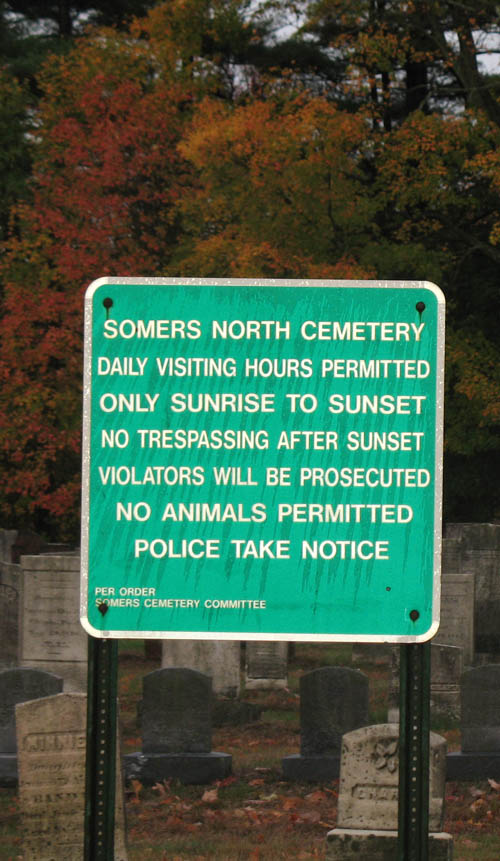
Samuel Hall and Sarah Rising had eight children, including our direct ancestor Samuel Hall who married Hannah Parsons. Samuel’s siblings include Sarah Hall, Mercy Hall, Bethia Hall, Abigail Hall, Eunice Hall, John Hall and Josiah Hall.
Samuel’s brother Josiah married Sarah Bush in Somers. Their children include Josiah Hall Jr., Joseph Hall, Sarah Hall, Vashti Hall, Mercy Hall, Terza Hall and Libni Hall.
Josiah Hall, Jr. married Elizabeth Russell. Their children include Josiah Hall, Joseph Hall, Alpheus Hall, Reuben Hall, Olla Hall, and Elizabeth Hall.
Many of the gravestones we have documented in North Cemetery in Somers reflect the monuments erected on behalf of Josiah Hall and Sarah (Bush) Hall’s offspring who lived their entire lives in Somers. I begin with Josiah Jr., and his family.
1. Gravestone of Josiah Hall, Jr., son of Josiah Hall and Sarah (Bush) Hall, b. 6 September 1744 in Somers. Inscription: In memory of Josiah Hall who died March 14, 1825, Age 80.

2. Gravestone of Elizabeth (Russell) Hall, b. 20 September 1745 in Somers. Inscription: In memory of Elizabeth, wife of Josiah Hall, who died March 20, 1814, aged 68.
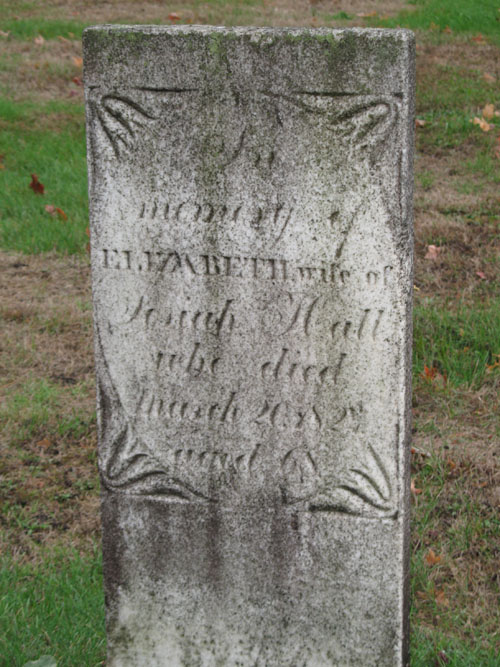
3. Gravestone of Joseph Hall, son of Josiah Hall, Jr. and Elizabeth (Russell) Hall, b. 17 March 1782. Inscription: Joseph Hall died April 17, 1844, Age 62.

4. Gravestone of Josiah Hall, son of Josiah Hall, Jr. and Elizabeth (Russell) Hall, b. 6 January 1776. Inscription: Josiah Hall died Sept. 3, 1852, Aged 75.

5. Gravestone of Olla, daughter of Josiah Hall, Jr. and Elizabeth (Russell) Hall, b. 8 August 1785. Inscription: In memory of Miss Olla daughter of Mr. Josiah and Mrs. Elizabeth Hall who died Dec. 6, 1810 in the [25th?] _____
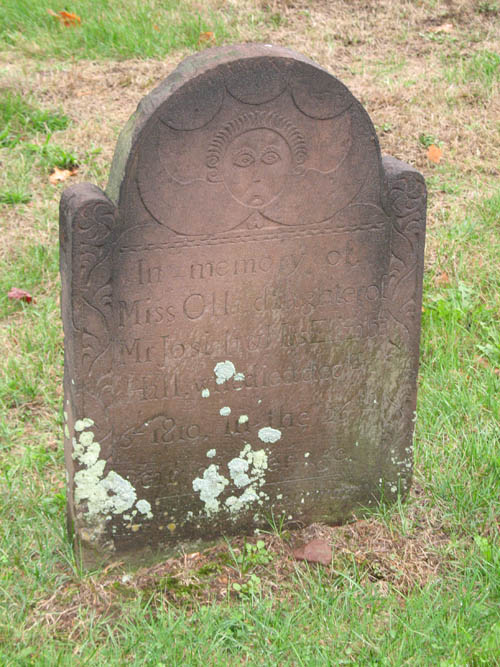
[Editor’s note: Son Alpheus removes to NY; son Reuben removes to OH.]
Topics: Connecticut | 1 Comment »
Somers
By Kathryn Hall | June 7, 2008
from History and Antiquities of Every Town in Connecticut by John Warner Barber (1836)
pp. 553 – 555

Somers is bounded N. by the Massachusetts line, W. by Enfield, E. by Stafford, and S. by Ellington. It is about six miles in length from north to south, with a mean breadth of about five miles. The central part of the town is 22 miles N. E. from Hartford, and 12 S. E. from Springfield, in Massachusetts. There is 1 Congregational and 1 Methodist church in the town ; there is also a considerable number of Baptists, who are associated with the Baptists churches in the neighboring towns.
The western section of the town is generally smooth and level, and free from stone. The eastern section is hilly and mountainous, with some heights of considerable elevation, affording an extensive and interesting prospect of Hartford, and the beautiful valley of the Connecticut.
Somers was formerly the southeast part of the ancient town of Springfield, granted by the General Court of Massachusetts to Mr. Pyncheon and his company. It was afterwards incorporated with the town of Enfield, and was part of the same ecclesiastical society, and so continued to be until about the year 1726, when it was made a distinct ecclesiastical society, by the General Court of Massachusetts, by the name of East Enfield.
The town of Enfield, when incorporated, extended from Connecticut river to Stafford, ten miles. The first person who moved on to Somers was Benjamin Jones, of Welch extraction. He was from Enfield; and in 1706 moved on to this tract where he resided in the summer,* but moved back in the winter, and at other times when danger was apprehended.
*This was near the foot of the mountain, on the principal road which passes through the town from Enfield to Stafford.
But no pemanent settlement was made until 1713, when Edward Kibbe, James Pease, Timothy Root, and John M’Gregory, with their families joined with Jones, and made a durable settlement. Soon after, several other families became residents in the town, by the names of Horton, Killam, Wood, Collins, Cittron, Davis, Sexton, Parsons, Blood, Purchase, Rockwood, Felt and Fisk.
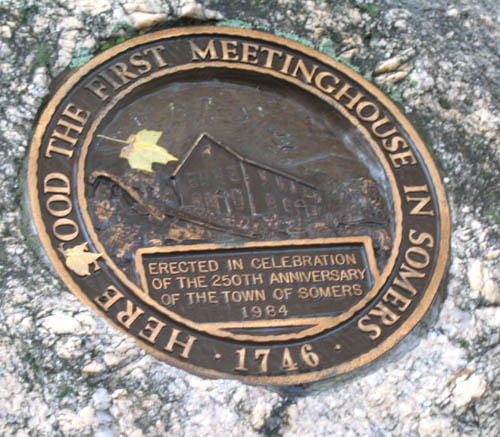
Their first pastor was the Rev. Samuel Allis, who was ordained in March, 1727. In 1731, the General court of Massachusetts incorporated the society as a town by file name of Somers. It is said to have been thus named at the request of Gov. Belcher, in honor of Lord Somers, for whom he had a peculiar respect and veneration.
[Editor’s note: According to The Early History of the Pease Families in America (1869), “It is said that Lord Somers sent the town a church bell because it was named for him, but for some cause, not satisfactorily explained, the bell never reached its destination, and the Somers church building was without a bell until a century afterwards.”]
The above [drawing at top] is a view of the central part of the town, where the two principal roads intersect each other at right angles. The principal village is situated on a street running east and west, and extending about a mile, The building on the extreme right is the Methodist church, recently erected; there, are perhaps 30 or 40 dwelling houses within half a mile of this building; the Congregational church is about half a mile to the north.
There are in the 4 or 5 mercantile stores, and one establishment, owned by Ebenezer Clark, Esq. for the manufacture of ladies’ straw bonnets, being, it is believed, the only one of the kind in the state. At present about 30 hands are employed, and about 100 hats manufactured daily. Part of the material, or straw, of which they are formed, is imported from abroad. Mr. Clark commenced the manufacture of these hats or bonnets about six years since.
“In the year 1775, a malignant fever prevailed in this town. It began about the first of August, and raged three months. This sickness had been immediately preceded by the scarlet fever and dysentery, which carried off a number. Thirty six persons died that year, of whom died of the fever, about one in twenty nine of the whole number of inhabitants in the town. It seized its patients with great violence, and frequently brought life to a close by the eight day and sometimes as early as the sixth. It rarely failed of attacking every person in the house where it entered, in its early stages.
The people in general were filled with great consternation. Nurses were procured with great difficulty, and, in some instances, the sick must have suffered, if recourse had not been had to legal coercion…The scenes of distress which opened among the sick and dying, can be remembered by those among us who were eye witnesses, but call not be described. ”
–Dr. Trumbull
Topics: Connecticut | No Comments »
Letter from Somers Historical Society
By Kathryn Hall | June 3, 2008
The following is a letter kindly written to me by Phyllis Lumb from the Somers Historical Society. The date on the envelope is May 12, 2003, Hartfield, CT.
Kathryn Hall
***********************************************************
May 10, 2003
Dear Kathryn Hall: re: Halls, Pease, Parsons, etc.
Luke Hall- b. July 4, 1744 Somers
son of Samuel Hall and Hannah Parsons
b. 2 Dec. 1710-probably Suffield, CT
m. Oct. 1, 1741 Somers
Hannah b. Sept. 20 1719
dau. of Luke Parsons–b. Jan. 4 1696, Enfield, C m. 1716
and Sarah Osborn b. Oct. 25 1696
Luke Parsons b. 1696 s/o Samuel Parsons and Hannah Hitchcock m. 1683From Parsons/Persons-record of Desc. of Reuben and Abigail Parsons in Somers collection
Luke Hall m. Elizabeth Cooley 4 Jan 1770 Somers–She b. Jan 7, 1748 Somers
her parents were Luke (4) Cooley, Eliakim (3), Eliakim,
Benjamin (1) and Elizabeth ColtonLuke Hall m. Martha (Mary/Molly) Davis Aug 5 1772 Somers
b. Mar 22 1754 Somers, dau of Isaac Davis, b 13 June 1716 and
Rachel Shedlon b. Suffield, CT 1721Luke Hall and Martha Davis–had Luke Jr. May 20, 1773 Somers
Luke Jr. m. Ruby Pease Jan 8, 1795
dau of Robert (6) Pease [Rbt. (5), Rbt. (4), Rbt. (3), John (2), Rbt. (1)]
and Ruby Cooley of Springfield, MA m. Mar 6 1776
b. Aug 19, 1756
Ruby Cooley was dau of Hezekiah (4) Cooley [Eliakim (3),
Eliakim (2), Benjamin Cooley]
and m. Jan 11, 1752 Lebanon, Ct
Charity Clark
b. abt. 1731 Lebanon, CT
d. Sept. 23, 1808 Longmeadow, MAfrom the History of the Cooley Family of Somers, W.D. Cooley Aug 2000
Topics: Connecticut | No Comments »
Introduction to Old Iron Works in Taunton
By Kathryn Hall | June 1, 2008

Fireback, Sussex Ironworks Collection, Sussex Archaelogical Society at Lewes.
“This 17th Century fireback represents a Sussex ironfounder and the implements of his trade. Inscription reads: ‘Richard Leonard, at Brede Fournis, 1636.’ ” from Kipling’s Sussex by Robert Thornton Hopkins. Photo provided courtesy of Brad Leonard. Note: no connection to the Taunton Leonards has been proven.
The following introduction to the Old Iron Works of Taunton, Massachusetts was written by Bristol County historian Maryan Nowak, who has kindly given his permission to reprint here. This introduction originally appeared on the site of The Taunton River. George Hall was an important player in the history of the Old Iron Works of Taunton. I will soon be posting old records documenting his role.
KH
IRON MAKING IN COLONIAL TAUNTON
*************************************
The beginnings of the iron industry came to the present Taunton area by the middle of the 17th century (1652) when Henry and James Leonard and Ralph Russell of Braintree were invited by the inhabitants “to set up a Bloomery Work on the Two Mile River”. It took some four years to accumulate sufficient capital, a dam to be built and heavy machinery to be imported for the iron works to become a reality. The records are not clear whether Henry Leonard and Ralph Russell were actually engaged in this works, for history finds them involved in iron workings in Dartmouth and Lynn during this period. However, the records are quite clear that James Leonard was a proprietor in the organization of the works in 1653-54. In 1656, the production of limited quantities of iron was finally begun.
In 1683, Captain Thomas Leonard, son of James, became the “clearke and manager” of the expanding works. It is through his ledgers that the history of Taunton iron making has been preserved from 1655 until his death in 1713.
James and Leonard, his sons, and their sons all engaged in iron manufacturing and became involved in the various works in and about the Taunton area. It appears that a “bloomerie” or forge was established at any location where good grade bog iron, a sizable river and an abundance of timber for charcoal was readily available. Some four works were operational in the Taunton area before 1700. It is to be remembered that early Taunton encompassed Raynham, Norton, Dighton and Berkley.
Iron became so important to the early settlers that not only shareholders and workers were paid in iron of various manufacture, but it served as a medium of exchange well into the 18th century. It is recorded that as late as 1751 Reverend John Wales of Raynham, received a third of his salary in bar iron.
As Taunton grew and iron works occupied main rivers and surrounding bogs, the search for suitable conditions expanded outward to where damnable streams with nearby bogs and timber stands began to be utilized.
Topics: Massachusetts | No Comments »
Somers North Cemetery: Hall Gravestones
By Kathryn Hall | May 28, 2008
Following are photos of gravestones of our direct Hall family, taken last fall by one of my first cousins who made the trek to the North Cemetery in Somers, Connecticut to document our family. To her we are grateful.
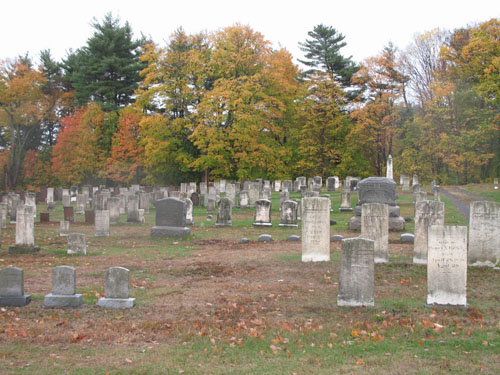
1. Gravestone of Samuel Hall, son of Samuel Hall and Sarah Rising, b. 2 Dec 1710 in Suffield, Hartford, CT; died 5 Nov. 1790. Inscription: In memory of Samuel Hall who died Nov…
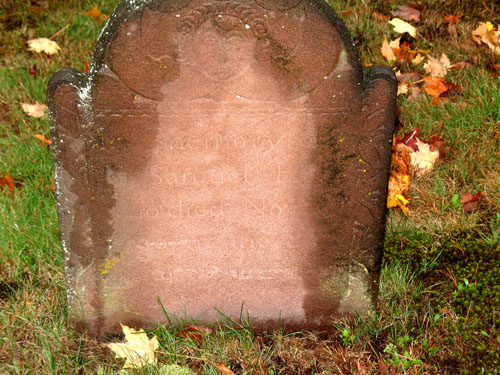
2. Gravestone of widow Hannah (Parsons) Hall, b 20 Sept. 1719 in Enfield, Hartford, CT; died 14 May 1803; m. Samuel Hall 1 Oct. 1741. Inscription: In Memory of Mrs. Hannah Hall Relect of Mr. Samuel Hall who died May 14, 1803 in her 84 year. Farewell vain world Thy joys decline…pleasures…beyond the grave.
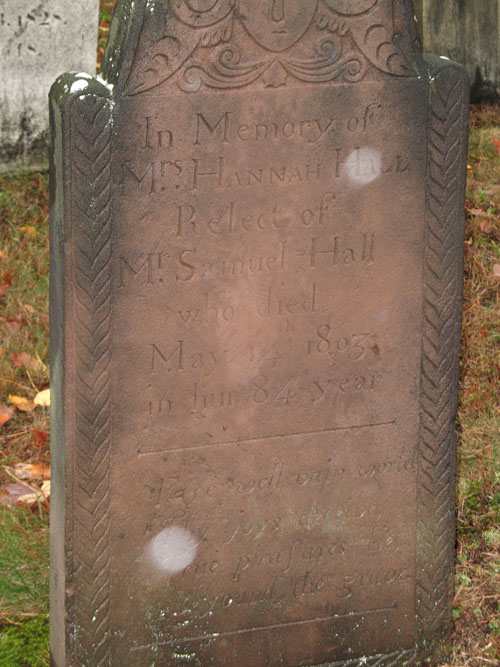
3. Gravestone of our Commissioned Officer and Patriot of the American Revolution, Lieutenant Luke Hall, b. 4 July 1744 in Somers; d. 19 Sept 1826 in Somers at age 82. Inscription: Lieut. Luke Hall died Sept. 19, 1826,–82, Integrity, morality and social order were the practiced principles of his life.
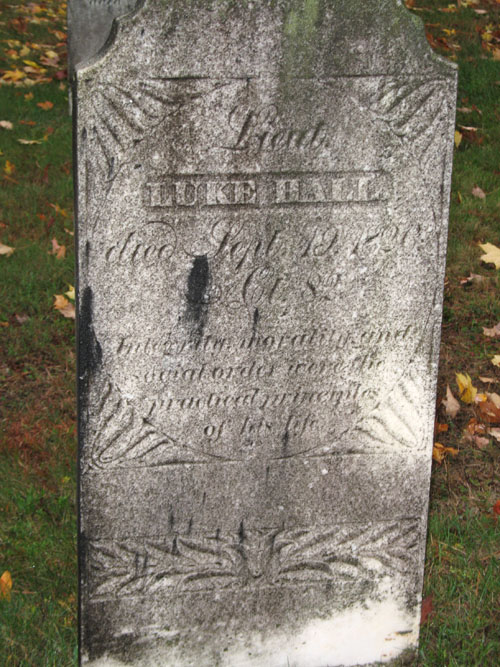
4. Gravestone of Lt. Luke Hall’s first wife, Elizabeth (Cooley) Hall, m. 4 Jan 1770 in Somers; d. 2 Feb. 17–(age 24). Inscription: In Memory of Mrs. Elizabeth, wife of Mr. Luke Hall who died Feb 2nd..year of her age…
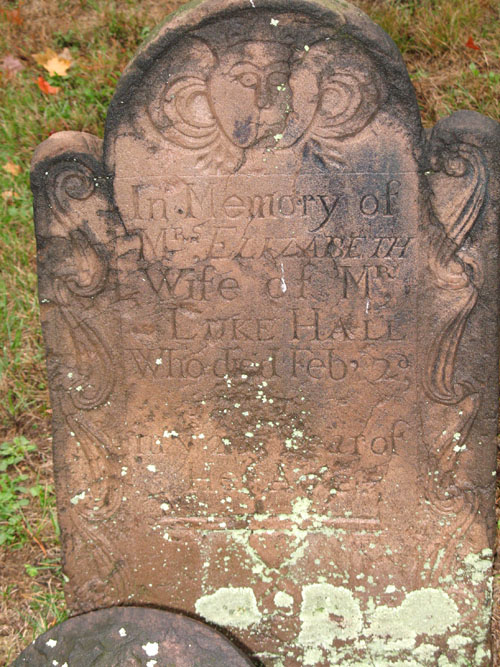
5. Gravestone of Lt. Luke Hall’s second wife, Martha “Molly” (Davis) Hall, b. 28 March, 1754 in Somers, CT; m. 5 Aug 1772; died 31 January 1821 at age 66, in Somers, CT. Inscription: In memory of Martha Hall, wife of Luke Hall…Jan…66

6. Gravestone of John Hall, son of Luke and Martha Hall. Inscription: In memory of Mr. John Hall son of Mr. Luke and Mrs. Martha Hall who died Nov. 14, 1814 in the 16 year.
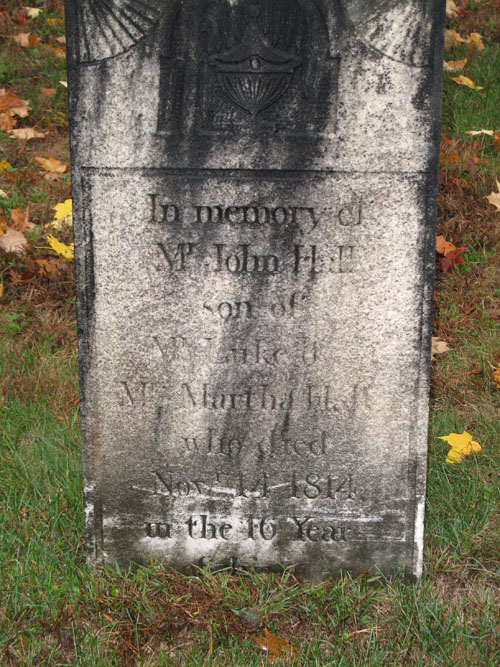
7. Gravestone of Hannah Hall, daughter of Luke and Martha Hall, sister to John. They died 15 days apart. John was 16; Hannah was 19. One can only imagine the grief this must have brought upon Luke and Martha. Inscription: …Hannah Hall daughter of Mr. Luke and Mrs. Martha Hall…died..Nov 29, 1814…age…
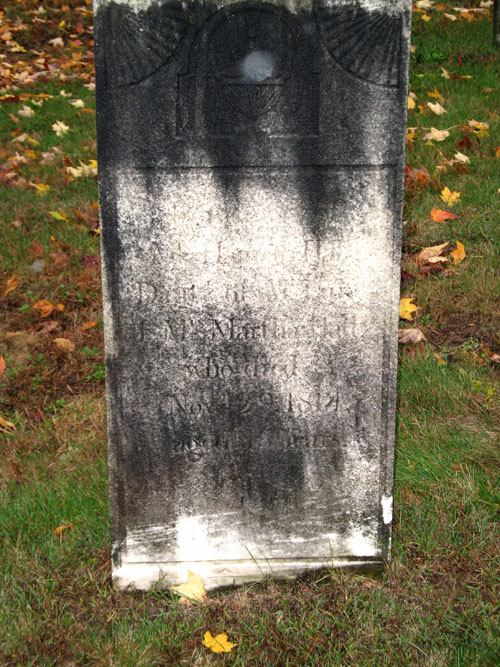
There are many many more Halls buried in Somers North Cemetery. In another post I will include cousins, aunts and uncles.
KH
Topics: Connecticut | 6 Comments »
« Previous Entries Next Entries »


